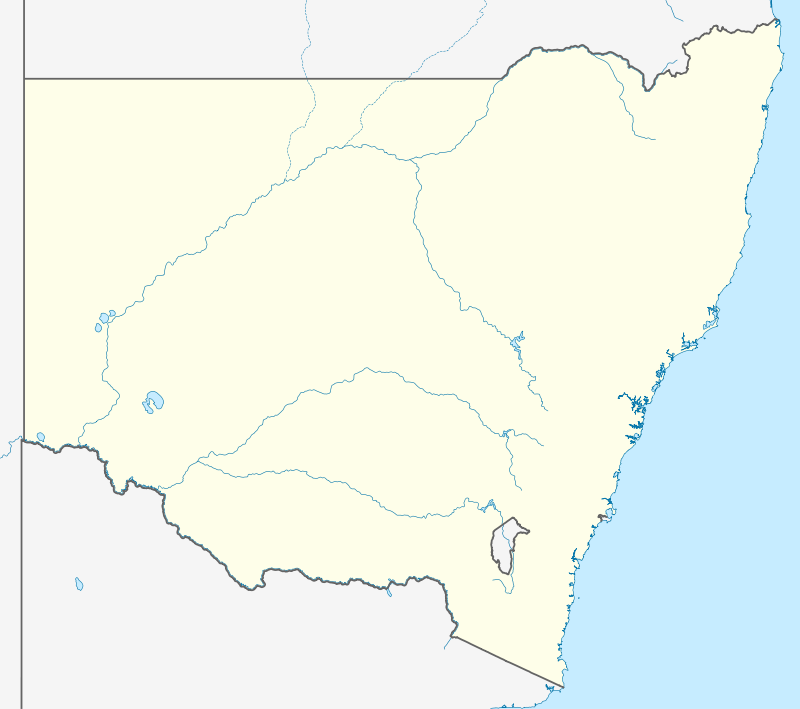Windsor Downs Nature Reserve
Windsor Downs Nature Reserve is a protected area established in 1990 by the Government of New South Wales. The nature reserve, which occupies an area of 364 hectares (900 acres), between Windsor Downs and Bligh Park, was established on land formerly owned by the Riverstone Meatworks for the grazing of cattle.[2]:5[1] It is one of the last remains of the Cumberland Plain Woodland, an endangered ecological community exclusive to what is now the western suburbs of Sydney. The nature reserve contains a wide range of flora including a number of Eucalypts as well as the threatened Persoonia nutans and Dillwynia tenuifolia as well as hosting a range of native fauna, including endangered species such as the Regent Honeyeater.
| Windsor Downs Nature Reserve Windsor Downs, New South Wales | |
|---|---|
IUCN category Ia (strict nature reserve)[1] | |
 The old meatworks water tower in the Windsor Downs Nature Reserve | |
 Windsor Downs Nature Reserve | |
| Coordinates | 33°38′59″S 150°48′09″E[1] |
| Established | 7 September 1990[1] |
| Area | 3.64 km2 (1.4 sq mi)[1] |
| Visitation | 10,000 (in 1999)[2]:25 |
| Managing authorities | NSW National Parks and Wildlife Service |
| Website | Windsor Downs Nature Reserve |
| See also | Protected areas of New South Wales |
History and Prior Land Use
Windsor Downs Nature Reserve is situated on the land of the Darug tribe. There are known to be aboriginal campsites in the reserve and a number of stone tools have been found.[2]:22
The land was occupied by the Riverstone Meatworks for over 100 years, during which time it was cleared and used for grazing cattle. Many of the structures from this period, including the old water tower and concrete water troughs are still standing to this day.[2]:24
In the late 1980s, shortly before their closure, the Meatworks sold the land to New South Wales National Parks and Wildlife, who opened the reserve as a state park in 1990[2]
The nature reserve was affected by a major fire on 10 September 2013. An investigation found that the fire was caused by a power line being blown down by strong winds.[3]
Flora
The reserve's flora is largely determined by its varying soil types. Open forest environment dominated by Iron-barks such as Eucalyptus fibrosa and Eucalyptus sideroxylon occur on the clay-based soils, while sandier soils host woodlands of Eucalyptus sclerophylla. Meanwhile, sub-mature Hakeas grow on former grazing land in the reserve.[2]
Additionally, the reserve is home to a number of rare and threatened flora including Dillwynia tenuifolia, Pultenaea parviflora, Persoonia nutans and Grevillea juniperina.[2]
Fauna
Mammals
The nature reserve hosts a healthy population of the Eastern grey kangaroo (Macropus Giganteus) as well as being home to Swamp wallabies, Sugar gliders, Common brushtail possums and Common ringtail possums.[2]
Birds
The nature reserve is reported to contain at least 68 bird species including Yellow-tailed black cockatoos, Sulphur-crested cockatoos and Laughing kookaburras. Notably, the endangered Regent honeyeater is known to reside in the reserve as well as possibly one of the few populations of Red-capped robins left in Sydney.[2]
Reptiles
The nature reserve is home to a number of reptiles including Goannas, Eastern brown snakes, Red-bellied black snakes and Blue-tongued lizards.[2]
References
- "Terrestrial Protected Areas of New South Wales (refer 'DETAIL' tab )". CAPAD 2018. Australian Government, Department of the Environment and Energy. 2018. Retrieved 25 October 2019.
- "Castlereagh, Agnes Banks and Windsor Downs Nature Reserves: Plan of Management" (PDF). NSW National Parks & Wildlife Service (PDF). Government of New South Wales. 5 March 1999. pp. 5, 10–11, 14–15, 17, 20, 22 24. ISBN 0-7310-7637-0. Retrieved 17 September 2014.
- "Fire Investigation Results Released". www.rfs.nsw.gov.au. Retrieved 5 November 2019.